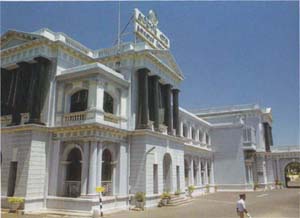|
If the shifting of the Tamil Nadu Assembly and Government Secretariat from Fort St George is welcomed by heritage enthusiasts and conservationists, the continuing lack of clarity on what is to be done with this precinct, surely a prime candidate for World Heritage status, is worrying. And the latest deliberations on whether the erstwhile Assembly premises ought to house an academic body does not fill us with hope.

The old Assembly and the Secretariat Complex.
|
For years now, Madras Musings has been pointing out the fact that Fort St. George suffers from a multitude of agencies and organisations, all of whom claim suzerainty over the areas they operate from within the premises. There is the Army, the Legislature, the Government of Tamil Nadu and also the Archaeological Survey of India (ASI). As a consequence, none appears to agree on what is best for this heritage precinct. Even as the complex is recovering from the recent vacating of its premises by the Government, it has become embroiled in a controversy between the party in power and those in the opposition.
In its general mood of opposing anything that is done by the party in power, the Opposition has announced that when it forms the Government it would do so at Fort St George and not in the new Assembly building. This has led to the powers currently in office to do some quick rethink on what was originally being planned for the erstwhile Assembly premises – namely converting it into a memorial and museum. In fact, the idea had so firmly taken root that none of the fixtures in the old Assembly was removed to the new building and care was taken to make an exact replica of the Speaker’s chair for the new location. But with the opposition painting different strokes, the Government has begun thinking up new ideas.
The latest is that the Secretariat and Assembly precincts in Fort St George can be made over to the Central Institute for Classical Tamil. This will mean the entire Assembly will need to be stripped of all its seating, wood panelling and be remodelled. That this is hardly the correct way to handle a heritage site is, of course, not being thought of. Having an academic institution shifting there will mean plenty of new construction work being taken up at the place. That means moving further away from the prospect of getting the place declared a World Heritage Site.
Interestingly, Fort St George is not the first heritage site to be considered for this Institute. A couple of years ago, it was announced that the Ice House would be taken over for this purpose once the lease agreement with the Ramakrishna Mission had run its course. The Government backtracked in the face of a volley of protests and the Institute was later housed in a building along the Marina.
While a suitable home for an institute devoted to the State’s classical language is an absolute must, it may be best to build an entirely new premises for it in one of the newly developed areas of the city, which would be in line with what the Government has done in respect of the new library that is coming up at Kotturpuram or, better still, use the old College of Fort St. George campus on College Road for this purpose. It was in this 19th Century college founded by R.W. Ellis, who first propounded the Dravidian origin of Tamil and the South Indian languages, that these languages benefited from the documenting and publishing of grammars and dictionaries. Converting a heritage building in a heritage precinct is not worthy of consideration at all. The Fort cannot become a pawn in a political game.
Fort St George is one of the most historical spots in our country, if not the whole world. It was here that the idea of an empire germinated – a thought owing to which much of later world history came to pass. It was also here that most of modern India’s institutions originated. That such a hallowed spot is not being considered for World Heritage status, when other cities in India have managed to qualify all kinds of places, including railway stations, is a matter of great concern. That steps are not even being taken to get such a certification underway is of course an indication of the lethargy that prevails in our State when it comes to matters concerning heritage.
|